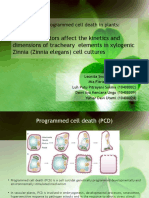Metaplasia
Metaplasia
Uploaded by
Md Ahsanuzzaman PinkuCopyright:
Available Formats
Metaplasia
Metaplasia
Uploaded by
Md Ahsanuzzaman PinkuCopyright
Available Formats
Share this document
Did you find this document useful?
Is this content inappropriate?
Copyright:
Available Formats
Metaplasia
Metaplasia
Uploaded by
Md Ahsanuzzaman PinkuCopyright:
Available Formats
Metaplasia
DEF: Metaplasia is a reversible change in which one differentiated cell type (epithelial or mesenchymal) is replaced by another cell type. It may represent an adaptive substitution of cells TYPE : The most common epithelial metaplasia is columnar to squamous 1. Epithelial metaplasia : 2 edged sowrd benefit- surviving against injurious agent, harm: fertile soil for malignant transformation [by persistence influence of metaplasia] A) Squamous metaplasia a) columner cell to squamaous cell - resp : Pseudo stratified ciliated Columnar cell > Stratified squamous.eg. smoker,COPD - GB : Columner > Squamous in chr. Cholecystitis - Uterus: Columner > Squamous in cervicitis endometrium occasionally - Prostate: C>S in BEP - Vit A deficiency: epi of resp,genitourinary, conjunctiva undergo squamous metaplasia - Duct of pancreas/salivary gland: normal secretory columner non functioning Str.squa epi b) Transitional to squamous - Urinary bladder: in Chr. Inflammation,calculi, schistosomiasis B) Columner metaplasia a) Intestinal metaplasia: epi of stomach replace by colonic epi. Liable for malignancy b) Barrets esophagus: Squamous epi replaced by intestinal like columner cell. Risk: adeno Ca c) Cervical erosion: vaginal cervix(squamous) replaced by columner cell d) Respiratory: Pseudostratified columner ciliated to simple mucous secreting in chr.bronchitis, bronchiectasis
2. Connective tissue metaplasia A) Osseus metaplasia: Fibroblast to osteoblast a) Aging of cartilage costal,thyroid b) Soft tissue scar,dystrophic calcification, caseous foci c) Myositis ossificans in muscle due to trauma, after supracondylar # in bending elbow (after intramuscular hemorrhage) B) Mesothelium: Squamous metaplasia in the pleura & peritoneum Mechanism: is the result of a reprogramming of stem cells - that are known to exist in normal tissues, or - of undifferentiated mesenchymal cells present in connective tissue. The differentiation of stem cells to a particular lineage is brought about by signals generated by cytokines, growth factors, and extracellular matrix components in the cells' environment or, the reserve cells (or stem cells) of the irritated tissue differentiate into a more protective cell type due to the influence of growth factors, cytokines, and matrix components
bad development. increase in growth of immature cells which reduces the growth of mature cells.
change of form. cell of specific type is replaced by another cell of another different shape.
Difference Between Dysplasia and Metaplasia The word Dysplasia is derived from a greek term meaning bad development. Metaplasia has derived its meaning from an another greek word meaning change of form. It is the process in which a cell of specific type is replaced by another cell of another different shape. Dysplasia is usually characterized by increase in growth of immature cells which reduces the growth of mature cells. Dysplasia is an indication of a young neo-plastic progression. It refers directly to the state of the cellular defect limited within the tissue of origin, for example, tumor. Cell transformations in metaplasia are often a result of the start of unusual stimulus. In this case, the original cells are not strong enough to live in the new environment that consists of unknown and unusual stimuli. There are four different stages of pathological change in dysplasia. Dysplasia and metaplasia are two different issues and not synonymous. Metaplasia are carcinogenic in nature. In contrast to dysplasia, metaplasia is caused due to stimulus and the same is responsible for the transformation. Cervical dysplasia is often caused by cervical infections.. The virus related to this infection is the virus that leads to other aspects of condyloma or genital warts. The virus is transmitted through sexual intercourse also. Sex with multiple partners increases the chances that women will become infected with HPV. The virus infects the cells lining the vagina and reproductive system of women. Although metaplasia occurs when normal cells face severe stress from a physiological and pathological forms. In such a state of stressed cells begin to adapt to changing situations with non-cancerous cell growth
Summary :.
1 Dysplasia is a pathologic term used to refer to errors that prevent cell growth within a given tissue, but metaplasia is the process of replacement of specific types of cells with other cells of corresponding maturity in different species. 2 Dysplasia is cancer and metaplasia are not cancer. 3. If the unusual stimulus is removed then metaplasia can be stopped, but dysplasia is a non-reversible process.
4. Dysplasia is pre-cancer Dysplasia refers to any disordered growth and maturation of an epithelium, which is still reversible if the factors driving it are eliminated. The description is similar to that of metaplasia, but there are several key differences. Metaplasia is not considered a part of carcinogenesis, and while dysplasias show a delay in maturation/differentiation of cells within tissues (e.g., expansion of immature cells with a corresponding decrease in number/change in location of mature cells), metaplasias have cells of one mature/differentiated type replace cells of another mature/differentiated type. Another way to describe dysplasias is by pathology: dysplasia is often the earliest form of pre-cancerous lesion recognizable in a pap smear or in a biopsy by a pathologist. Dysplasias can be low grade or high grade. The risk of a low-grade dysplasia transforming into a high-grade dysplasia (and eventually to cancer) is low. "High-grade dysplasia" is often synonymous with "carcinoma in situ." These dysplasias represent a more advanced progression towards malignant transformation, and the risk of high-grade dysplasias transforming into cancer is high. When the entire epithelium is dysplastic and no normal epithelial cells are present, the growth is termed a neoplasia
4. Hyperplasia
a. Definition: an increase in the number of cells in a tissue or organ b. Some cell types are unable to exhibit hyperplasia (e.g., nerve, cardiac, skeletal muscle cells) c. Physiologic causes of hyperplasia i. Compensatory e.g. - after partial hepatectomy - after unilateral nephrectomy ii. Hormonal stimulation e.g. - glandular epi breast development at puberty & Pg - Pg uterus iii. Antigenic stimulation (e.g.,lymphoid hyperplasia) d. Pathologic causes of hyperplasia i. Endometrial hyperplasia ii. Prostatic hyperplasia of aging of thyroid gland skin warts (epidermal hyperplasia) due to pappiloma virus in healing process e. Hyperplasia is mediated by i. Growth factors, cytokines, and other trophic stimuli ii. Increased expression of growth-promoting genes (proto-oncogenes) iii. Increased DNA synthesis and cell division (mitotic division) 3, Mechanisms of hyperplasia a. Dependent on the regenerative capacity of different types of cells b. Labile cells (stem cells) (1) Divide continuously (may form new cell) Labile/stable (2) Examplesstem cells in the bone marrow, stem cells in the crypts of cells; can Lieberkuhn, and basal cells in the epidermis (3) May undergo hyperplasia as an adaptation to cell injury Divide
Permanent cells; cant
c. Stable cells (resting cells) (1) Divide infrequently, because they are normally in the G0, (resting) phase (2) Must be stimulated (e.g., growth factors, hormones) to enter the cell cycle (3) Exampleshepatoeytes, astrocytes, smooth muscle cells (4) May undergo hyperplasia or hypertrophy as an adaptation to cell injury d. Permanent cells (nonreplicating cells) (1) Highly specialized cells that cannot replicate (2) Examplesneurons and skeletal and cardiac muscle cells 4, Inereased risk for progressing into dysplasia and cancer, in some cases (see later) Example-endometrial hyperplasia
You might also like
- Solutions For Applied Pathophysiology 4th Us Edition by NathDocument15 pagesSolutions For Applied Pathophysiology 4th Us Edition by NathtestbankyNo ratings yet
- The Secrets To Gaining Muscle Mass Fast by Anthony Ellis PDFDocument125 pagesThe Secrets To Gaining Muscle Mass Fast by Anthony Ellis PDFVishal DokaniaNo ratings yet
- Multi Step CarcinogenesisDocument27 pagesMulti Step CarcinogenesisANSH RAIZADA 20BOE10026No ratings yet
- PECOMADocument25 pagesPECOMAAnan JaiswalNo ratings yet
- Evolution of Parasitism PDFDocument2 pagesEvolution of Parasitism PDFChad0% (2)
- Cellular Adaptation DR AMAL D & T DR AMAL 2023 LectureDocument34 pagesCellular Adaptation DR AMAL D & T DR AMAL 2023 Lectured2zd4s2fxgNo ratings yet
- Neoplasma Lecture For FKG''Document62 pagesNeoplasma Lecture For FKG''ginulNo ratings yet
- Stem Cell IsscrDocument8 pagesStem Cell Isscrcazzy_luvNo ratings yet
- Mitosis: Labeled Diagram: Interphase: Gap 1 Phase (Growth), Synthesis Phase (Copy of DNA), Gap 2 Phase (OrganelleDocument7 pagesMitosis: Labeled Diagram: Interphase: Gap 1 Phase (Growth), Synthesis Phase (Copy of DNA), Gap 2 Phase (Organelleazzahra adeliaNo ratings yet
- Apoptosis PPT, Pathological AnatomyDocument15 pagesApoptosis PPT, Pathological AnatomyN J3 CNo ratings yet
- Overview of Cell Cycle by Javali.GDocument15 pagesOverview of Cell Cycle by Javali.GJavali.GNo ratings yet
- Cellular Pathology: Normal CellsDocument22 pagesCellular Pathology: Normal CellsPrakash PanthiNo ratings yet
- 3 Cellular Adaptation and DifferentiationDocument32 pages3 Cellular Adaptation and Differentiationvinoedhnaidu_rajagopalNo ratings yet
- Cancer The Inimate EnemyDocument2 pagesCancer The Inimate EnemyAlaa EddinNo ratings yet
- Lab Report Cell Bio MitosisDocument4 pagesLab Report Cell Bio Mitosisain syukriahNo ratings yet
- Genetic Disorders IIIDocument42 pagesGenetic Disorders IIIBahzad AkramNo ratings yet
- Invasion and Tumour MetastasisDocument33 pagesInvasion and Tumour MetastasisShimmering MoonNo ratings yet
- Mapeh BrochureDocument1 pageMapeh BrochureRio PerezNo ratings yet
- Antitumor Effector Mechanisms & Immune Surveillance: Imelda Salas LorenzoDocument11 pagesAntitumor Effector Mechanisms & Immune Surveillance: Imelda Salas LorenzoironNo ratings yet
- Lymphatic Organs and TissuesDocument3 pagesLymphatic Organs and TissuesSaman Bharatha KotigalaNo ratings yet
- # Disaggregation Process Mechanical DisaggregationDocument3 pages# Disaggregation Process Mechanical DisaggregationlkokodkodNo ratings yet
- Animal Cell CultureDocument33 pagesAnimal Cell CultureMd. Babul AktarNo ratings yet
- Molecular Basis of CancerDocument6 pagesMolecular Basis of CancerguptaamitalwNo ratings yet
- Disorders of Cell Growth & NeoplasiaDocument62 pagesDisorders of Cell Growth & NeoplasiaPrakash PanthiNo ratings yet
- Numerical Aberrations: Meiotic NondisjunctionDocument36 pagesNumerical Aberrations: Meiotic NondisjunctionHemanth_Prasad_2860No ratings yet
- 2.disorders of Cell Growth & Cellular AdaptationDocument41 pages2.disorders of Cell Growth & Cellular AdaptationDoc On CallNo ratings yet
- The Immune System and Immunity: By: Princess Nhoor A. AgcongDocument24 pagesThe Immune System and Immunity: By: Princess Nhoor A. AgcongCess Abad AgcongNo ratings yet
- Apoptotic-Like Programmed Cell Death in PlantsDocument18 pagesApoptotic-Like Programmed Cell Death in PlantsLeonita SwandjajaNo ratings yet
- Anat 4.3 GIT Histo - ZuluetaDocument8 pagesAnat 4.3 GIT Histo - Zuluetalovelots1234No ratings yet
- Cell Adaptation and Changes 1Document42 pagesCell Adaptation and Changes 1ariffdrNo ratings yet
- NF-KB and The Immune ResponseDocument23 pagesNF-KB and The Immune ResponseAndri Praja SatriaNo ratings yet
- CitologieDocument14 pagesCitologieAlexandra CrisanNo ratings yet
- Cell Cycle: SPEAKER-Dr - Ayesha.Juhi Coordinator-Dr - Ravindra.P.NDocument38 pagesCell Cycle: SPEAKER-Dr - Ayesha.Juhi Coordinator-Dr - Ravindra.P.NAyesha SKNo ratings yet
- XII Supplementary Material Biology (Revised) PDFDocument36 pagesXII Supplementary Material Biology (Revised) PDFlithika sri kNo ratings yet
- Biology Class Ix Reference Study Material PDFDocument219 pagesBiology Class Ix Reference Study Material PDFVishal50% (2)
- Pathology (1,2,3) - AFR DesktopDocument56 pagesPathology (1,2,3) - AFR DesktopNAYEEMA JAMEEL ANUVANo ratings yet
- Chapter 7 - Mechanisms of Cell DeathDocument22 pagesChapter 7 - Mechanisms of Cell DeathCynthia Lopes100% (1)
- Genetics of Development in Plants - NOTESDocument40 pagesGenetics of Development in Plants - NOTESSanthoshNo ratings yet
- LymphangioleiomyomatosisDocument11 pagesLymphangioleiomyomatosisJimmyNo ratings yet
- 120-Nr-M.D. Degree Examination - June, 2008-Pathology-Paper-IDocument16 pages120-Nr-M.D. Degree Examination - June, 2008-Pathology-Paper-IdubaisrinivasuluNo ratings yet
- FRCPath Part 1 Course - Day 1Document11 pagesFRCPath Part 1 Course - Day 1Marvi UmairNo ratings yet
- ADAMANTINOMADocument8 pagesADAMANTINOMAfadhlanahmadsNo ratings yet
- Round Cell Tumors FinalDocument86 pagesRound Cell Tumors FinalKush Pathak100% (2)
- Lesson 31. Lymph NodesDocument24 pagesLesson 31. Lymph NodesLola P100% (1)
- Molecular-Basis-of-Cancer-Behavior CREDITS TO OWNERDocument58 pagesMolecular-Basis-of-Cancer-Behavior CREDITS TO OWNERtfiveNo ratings yet
- Apoptosis PDFDocument67 pagesApoptosis PDFmkman100% (1)
- Primary and Secondary Lymphoid Organs - Aditi SinghDocument50 pagesPrimary and Secondary Lymphoid Organs - Aditi SinghEunice PalloganNo ratings yet
- Entamoeba HistoyticaDocument25 pagesEntamoeba HistoyticaUmar FarooqNo ratings yet
- Pathology TutorialDocument12 pagesPathology TutorialjessbunkerNo ratings yet
- Cell Cycle and Cell ControlDocument18 pagesCell Cycle and Cell ControlSTANLY MORALESNo ratings yet
- Cilia and FlagellaDocument25 pagesCilia and FlagellaLia Savitri RomdaniNo ratings yet
- Lecture 6-Repair & Healing - 382Document33 pagesLecture 6-Repair & Healing - 382MirghaniNo ratings yet
- Policies: Attendance - ID & Uniform - Quizzes - Grading System - 40% Quizzes - 30% Manual - 10% Exam - 60%Document67 pagesPolicies: Attendance - ID & Uniform - Quizzes - Grading System - 40% Quizzes - 30% Manual - 10% Exam - 60%kamiya008100% (1)
- Eukaryotic Cell CycleDocument96 pagesEukaryotic Cell CycleRaghav Oberoi100% (1)
- Cell Cycle Cell Division EditedDocument96 pagesCell Cycle Cell Division Editedmitsuri ʚĭɞNo ratings yet
- Case ReportDocument2 pagesCase ReportNarendran KumaravelNo ratings yet
- MEN1 PPDocument15 pagesMEN1 PPAaron D. PhoenixNo ratings yet
- Cell Growth Patterns/Disorders of Growth: Prof - Abdul Jabbar N. Al-ShammariDocument52 pagesCell Growth Patterns/Disorders of Growth: Prof - Abdul Jabbar N. Al-Shammariمختبرات ابوسارةNo ratings yet
- Prof - Abdul Jabbar N. Al-ShammariDocument51 pagesProf - Abdul Jabbar N. Al-Shammariمختبرات ابوسارةNo ratings yet
- Lecture On Cellular Aberration BiologyDocument68 pagesLecture On Cellular Aberration BiologyleanavillNo ratings yet
- Cancer Biology, a Study of Cancer Pathogenesis: How to Prevent Cancer and DiseasesFrom EverandCancer Biology, a Study of Cancer Pathogenesis: How to Prevent Cancer and DiseasesNo ratings yet
- Scan 2Document1 pageScan 2Md Ahsanuzzaman PinkuNo ratings yet
- NIH Public Access: Author ManuscriptDocument47 pagesNIH Public Access: Author ManuscriptMd Ahsanuzzaman PinkuNo ratings yet
- Kiapour2014 PDFDocument12 pagesKiapour2014 PDFMd Ahsanuzzaman PinkuNo ratings yet
- Wrist Anatomy and Surgical Approaches: Roy Cardoso, MD, Robert M. Szabo, MD, MPHDocument22 pagesWrist Anatomy and Surgical Approaches: Roy Cardoso, MD, Robert M. Szabo, MD, MPHMd Ahsanuzzaman PinkuNo ratings yet
- Provider-9773 PDFDocument1 pageProvider-9773 PDFMd Ahsanuzzaman PinkuNo ratings yet
- Anatomy and Biomechanics of The Cruciate Ligaments and Their Surgical ImplicationsDocument12 pagesAnatomy and Biomechanics of The Cruciate Ligaments and Their Surgical ImplicationsMd Ahsanuzzaman PinkuNo ratings yet
- Chondroma: X-Ray ShowsDocument2 pagesChondroma: X-Ray ShowsMd Ahsanuzzaman PinkuNo ratings yet
- Overstuffed LibraryDocument1 pageOverstuffed LibraryMd Ahsanuzzaman PinkuNo ratings yet
- RBZV E VSK WJWG Uw: Cöavb KVH©VJQ, XVKVDocument5 pagesRBZV E VSK WJWG Uw: Cöavb KVH©VJQ, XVKVMd Ahsanuzzaman PinkuNo ratings yet
- Coxa VaraDocument3 pagesCoxa VaraMd Ahsanuzzaman PinkuNo ratings yet
- Pathology:: Severity of Lesion: The Lesion May BeDocument2 pagesPathology:: Severity of Lesion: The Lesion May BeMd Ahsanuzzaman PinkuNo ratings yet
- Online Registration For ConvocationDocument1 pageOnline Registration For ConvocationMd Ahsanuzzaman PinkuNo ratings yet
- Non Ossifying Fibrous DefectDocument2 pagesNon Ossifying Fibrous DefectMd Ahsanuzzaman PinkuNo ratings yet
- Flail ChestDocument3 pagesFlail ChestMd Ahsanuzzaman PinkuNo ratings yet
- Knee DeformityDocument7 pagesKnee DeformityMd Ahsanuzzaman PinkuNo ratings yet
- Mal UnionDocument1 pageMal UnionMd Ahsanuzzaman PinkuNo ratings yet
- Bone Healing & Metabolic & Devolopmental DisorderDocument2 pagesBone Healing & Metabolic & Devolopmental DisorderMd Ahsanuzzaman PinkuNo ratings yet
- My Experience in Paediatric Orthopaedics at Sanchetti Institute For Orthopaedics and RehabilitationDocument48 pagesMy Experience in Paediatric Orthopaedics at Sanchetti Institute For Orthopaedics and RehabilitationMd Ahsanuzzaman PinkuNo ratings yet
- Fractures Around The WristDocument3 pagesFractures Around The WristMd Ahsanuzzaman PinkuNo ratings yet
- Femur TrabeculeDocument2 pagesFemur TrabeculeMd Ahsanuzzaman PinkuNo ratings yet
- Pharamcology and PharmacotherapeuticsDocument1 pagePharamcology and PharmacotherapeuticsTzvineZNo ratings yet
- The Vertical Jump Development Bible TrainingDocument8 pagesThe Vertical Jump Development Bible TrainingAnonymous mEfwscKONo ratings yet
- 099 - VaccinesDocument4 pages099 - VaccinesArjan LallNo ratings yet
- Cardiovascula R Imaging: Dept. of Diagnostic Radiology Diponegoro Univ./Dr - Kariadi General HospitalDocument85 pagesCardiovascula R Imaging: Dept. of Diagnostic Radiology Diponegoro Univ./Dr - Kariadi General HospitalvaniaNo ratings yet
- Name - Suraj Sala-WPS OfficeDocument7 pagesName - Suraj Sala-WPS OfficeMariam UmarNo ratings yet
- Surgery Reviosn NotesDocument41 pagesSurgery Reviosn Noteshy7tn100% (2)
- OB Version BDocument6 pagesOB Version Bisapatrick8126100% (1)
- 3 Week Review StudyPlanDocument2 pages3 Week Review StudyPlanSNo ratings yet
- Adaptogens: A Review of Their History, Biological Activity, and Clinical BenefitsDocument12 pagesAdaptogens: A Review of Their History, Biological Activity, and Clinical BenefitsGuaguancon100% (1)
- Healthcare Services (Clinical Laboratory Service ADocument48 pagesHealthcare Services (Clinical Laboratory Service AJackNo ratings yet
- PeritonitisDocument19 pagesPeritonitisAditya SahidNo ratings yet
- Ah102 Syllabus 20180417Document7 pagesAh102 Syllabus 20180417api-410716618No ratings yet
- App LetterDocument2 pagesApp LetterJoel PaunilNo ratings yet
- Introductory Mandarin (Level Iii) : Prepared byDocument5 pagesIntroductory Mandarin (Level Iii) : Prepared byFinn Harries100% (1)
- Calcium ImbalancesDocument3 pagesCalcium ImbalancesAna Dominique EspiaNo ratings yet
- PHD MPhil BrochureDocument10 pagesPHD MPhil BrochurenandukyNo ratings yet
- Fitting and Modifying Hearing InstrumentsDocument32 pagesFitting and Modifying Hearing Instrumentsentgo8282No ratings yet
- Guidelines For Shelf-Life of Medical ProductsDocument3 pagesGuidelines For Shelf-Life of Medical ProductsArvenaa SubramaniamNo ratings yet
- Parts of The Human Eye With DefinitionDocument4 pagesParts of The Human Eye With DefinitionStarsky Allence Puyoc0% (1)
- 2006 Lange OutlineDocument570 pages2006 Lange Outlinemequanint kefieNo ratings yet
- Exclusive Interview With Dr. Manish BhartiyaDocument2 pagesExclusive Interview With Dr. Manish BhartiyaHomoeopathic PulseNo ratings yet
- The Wim Hof MethodDocument5 pagesThe Wim Hof MethodAgro ChimpNo ratings yet
- Kinnser + Direct Data Entry (DDE)Document13 pagesKinnser + Direct Data Entry (DDE)Kinnser SoftwareNo ratings yet
- Indian Medicinal Plants 2007Document76 pagesIndian Medicinal Plants 2007Amit patelNo ratings yet
- Ergonomics FlyerDocument2 pagesErgonomics Flyerthomaas_thomaasNo ratings yet
- NRSG 115 CCL CDL Spring 2020 Lab Information SheetDocument7 pagesNRSG 115 CCL CDL Spring 2020 Lab Information SheetSethNo ratings yet
- Lips Gateway To EstheticsDocument97 pagesLips Gateway To EstheticsSagar KhatriNo ratings yet
- Annual Review of CyberTherapy and Telemedicine, Volume 7, Summer 2009Document296 pagesAnnual Review of CyberTherapy and Telemedicine, Volume 7, Summer 2009Giuseppe Riva100% (3)
- RR 2-98 - Withholding TaxesDocument99 pagesRR 2-98 - Withholding TaxesbiklatNo ratings yet













































































































